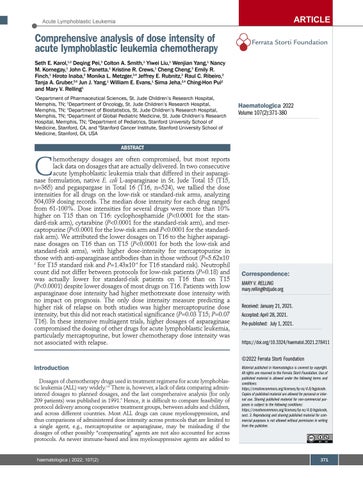ARTICLE
Acute Lymphoblastic Leukemia
Comprehensive analysis of dose intensity of acute lymphoblastic leukemia chemotherapy
Ferrata Storti Foundation
Seth E. Karol,1,2 Deqing Pei,3 Colton A. Smith,1 Yiwei Liu,1 Wenjian Yang,1 Nancy M. Kornegay,1 John C. Panetta,1 Kristine R. Crews,1 Cheng Cheng,3 Emily R. Finch,1 Hiroto Inaba,2 Monika L. Metzger,2,4 Jeffrey E. Rubnitz,2 Raul C. Ribeiro,2 Tanja A. Gruber,5,6 Jun J. Yang,1 William E. Evans,1 Sima Jeha,2,4 Ching-Hon Pui2 and Mary V. Relling1 Department of Pharmaceutical Sciences, St. Jude Children’s Research Hospital, Memphis, TN; 2Department of Oncology, St. Jude Children’s Research Hospital, Memphis, TN; 3Department of Biostatistics, St. Jude Children’s Research Hospital, Memphis, TN; 4Department of Global Pediatric Medicine, St. Jude Children’s Research Hospital, Memphis, TN; 5Department of Pediatrics, Stanford University School of Medicine, Stanford, CA, and 6Stanford Cancer Institute, Stanford University School of Medicine, Stanford, CA, USA
1
Haematologica 2022 Volume 107(2):371-380
ABSTRACT
C
hemotherapy dosages are often compromised, but most reports lack data on dosages that are actually delivered. In two consecutive acute lymphoblastic leukemia trials that differed in their asparaginase formulation, native E. coli L-asparaginase in St. Jude Total 15 (T15, n=365) and pegaspargase in Total 16 (T16, n=524), we tallied the dose intensities for all drugs on the low-risk or standard-risk arms, analyzing 504,039 dosing records. The median dose intensity for each drug ranged from 61-100%. Dose intensities for several drugs were more than 10% higher on T15 than on T16: cyclophosphamide (P<0.0001 for the standard-risk arm), cytarabine (P<0.0001 for the standard-risk arm), and mercaptopurine (P<0.0001 for the low-risk arm and P<0.0001 for the standardrisk arm). We attributed the lower dosages on T16 to the higher asparaginase dosages on T16 than on T15 (P<0.0001 for both the low-risk and standard-risk arms), with higher dose-intensity for mercaptopurine in those with anti-asparaginase antibodies than in those without (P=5.62x103 for T15 standard risk and P=1.43x10-4 for T16 standard risk). Neutrophil count did not differ between protocols for low-risk patients (P=0.18) and was actually lower for standard-risk patients on T16 than on T15 (P<0.0001) despite lower dosages of most drugs on T16. Patients with low asparaginase dose intensity had higher methotrexate dose intensity with no impact on prognosis. The only dose intensity measure predicting a higher risk of relapse on both studies was higher mercaptopurine dose intensity, but this did not reach statistical significance (P=0.03 T15; P=0.07 T16). In these intensive multiagent trials, higher dosages of asparaginase compromised the dosing of other drugs for acute lymphoblastic leukemia, particularly mercaptopurine, but lower chemotherapy dose intensity was not associated with relapse.
Correspondence: MARY V. RELLING mary.relling@stjude.org Received: January 21, 2021. Accepted: April 28, 2021. Pre-published: July 1, 2021. https://doi.org/10.3324/haematol.2021.278411
©2022 Ferrata Storti Foundation
Introduction Dosages of chemotherapy drugs used in treatment regimens for acute lymphoblastic leukemia (ALL) vary widely.1-8 There is, however, a lack of data comparing administered dosages to planned dosages, and the last comprehensive analysis (for only 209 patients) was published in 1991.9 Hence, it is difficult to compare feasibility of protocol delivery among cooperative treatment groups, between adults and children, and across different countries. Most ALL drugs can cause myelosuppression, and thus comparisons of administered dose intensity across protocols that are limited to a single agent, e.g., mercaptopurine or asparaginase, may be misleading if the dosages of other possibly “compensating” agents are not also accounted for across protocols. As newer immune-based and less myelosuppressive agents are added to
haematologica | 2022; 107(2)
Material published in Haematologica is covered by copyright. All rights are reserved to the Ferrata Storti Foundation. Use of published material is allowed under the following terms and conditions: https://creativecommons.org/licenses/by-nc/4.0/legalcode. Copies of published material are allowed for personal or internal use. Sharing published material for non-commercial purposes is subject to the following conditions: https://creativecommons.org/licenses/by-nc/4.0/legalcode, sect. 3. Reproducing and sharing published material for commercial purposes is not allowed without permission in writing from the publisher.
371




